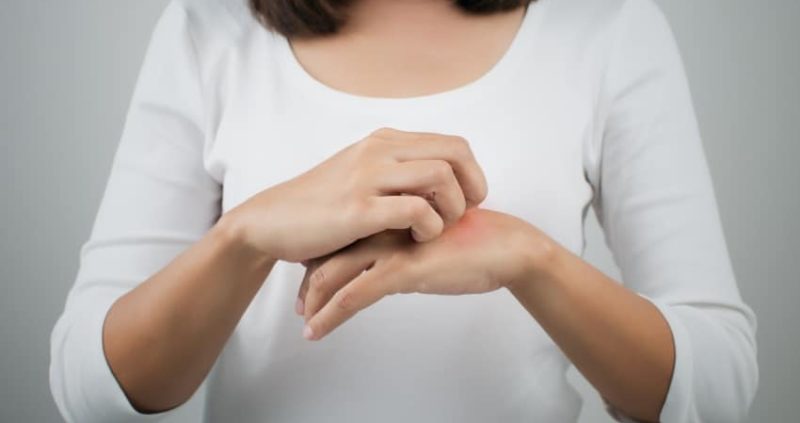Hives is a condition of the skin also known as Urticaria. It consists of the outbreak of red, swollen bumps, commonly known as wheels.
It is accompanied by several itching. This reaction is sudden, and it may occur due to allergies or due to unknown causes.
In this article, you can find information about the symptoms, causes, diagnosis, types, treatment, management, and natural remedies.
Table of Contents
What Are Hives?

Hives are welts that can appear on the skin of any part of the body, including face, ears, tongue, lips, throat, limbs, etc.
Their size has a very wide range, from a few millimeters to several centimeters in diameter. Moreover, hives can also join to form an even larger mark.
They lead to a severe itching, burning, or stinging sensation.
Hives tend to disappear within a day, but there is a chance that new ones appear as the old ones fade.
This process may repeat itself for up to 6 weeks in case of an acute case of hives. If it lasts for more time, it will be considered a chronic case.
Hives are commonly triggered by allergies, but this is not their only causative factor. Sometimes hives occur associated with angioedema, which implies the deepening of this reaction into the skin.
It often can cause swelling around the eyes, lips, genitals, feet, and hands and sometimes it may block the air passages. This condition requires immediate medical assistance.
Home Remedies To Get Rid Of Hives Permanently
Hives are commonly harmless. In most of the cases, they heal by themselves in a period of a few days. However, they can be a very uncomfortable condition. Here are some simple home remedies that can provide you some relief from hives:
1. Cold Compress
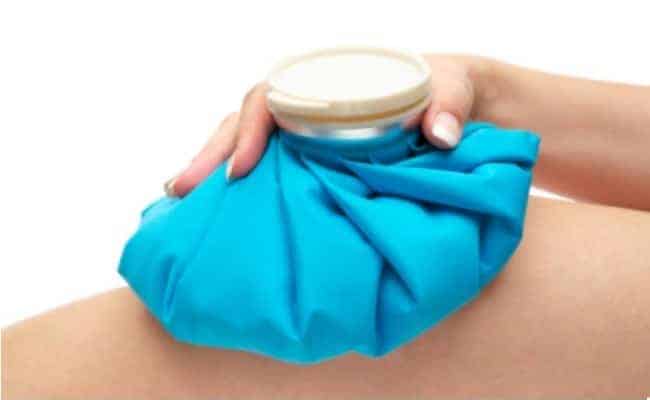
- This is the most common and obvious remedy for soothing the itchiness produced by hives and other skin conditions.
- The secret behind this method lies in the effect of cold temperature of shrinking the blood vessels and preventing the release of more histamine. This is how cold compresses relieve swelling, itching, and inflammation.
- Cold compresses can be made by wrapping a few ice cubes with a cloth and placing them on the affected skin for a few minutes. This process can be repeated from three to four times a day. Make sure you never apply ice directly on the skin as this can damage it more.
- Apart from cold compresses, other cooling methods include cool baths or showers.
2. Baking Soda
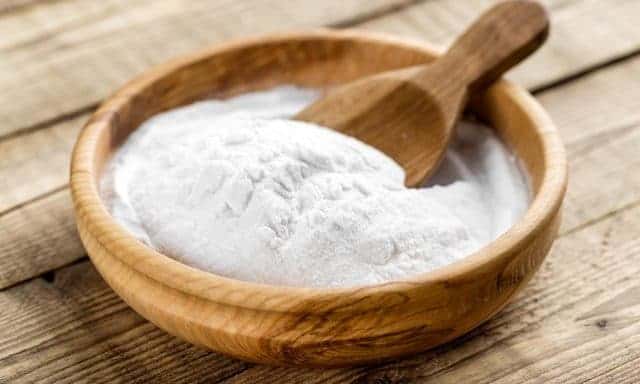
- This ingredient is an anti-inflammatory that helps in reducing swelling and itching. It can be used by adding a cup of it into warm water in a bathtub.
- Soak the affected skin in this soda and water mixture for twenty to thirty minutes a day. Baking soda can also be applied directly to the skin in the form of a paste made with water.
- The paste should be applied to the affected area and rinsed with warm water after a few minutes.
3. Turmeric
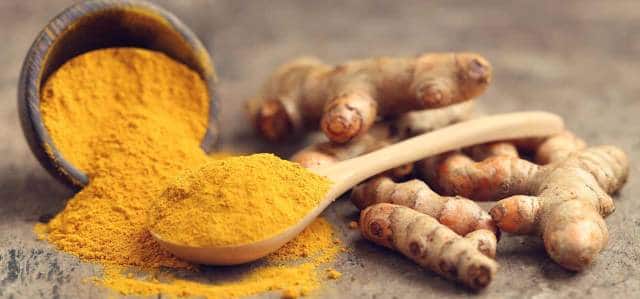
- This spice commonly found in the Indian kitchens has several healing properties. It is an anti-inflammatory, antioxidant, and antihistamine substance.
- Turmeric powder can be added to a glass of hot milk mixed with honey. It can also be used as a food ingredient.
4.Ginger
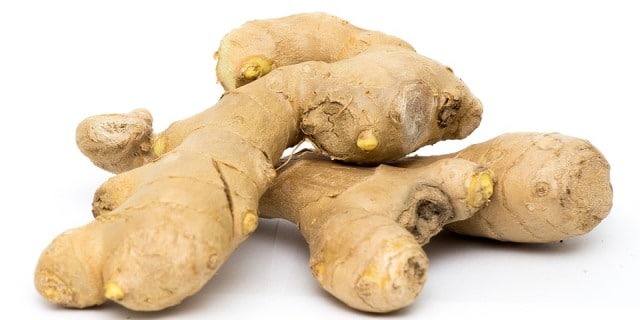
- One of the many healing properties of ginger is the curing of hives. It has strong antihistamine and anti-inflammatory properties; it stimulates blood circulation reducing swelling and itchiness.
- Ginger can be taken in the form of tea or chewed every day a few times.
- Also, ginger can be applied to the affected skin two to three times a day. For this purpose peel a small piece of ginger and keep it in the fridge for a few minutes to obtain a cooling effect.
5. Oatmeal
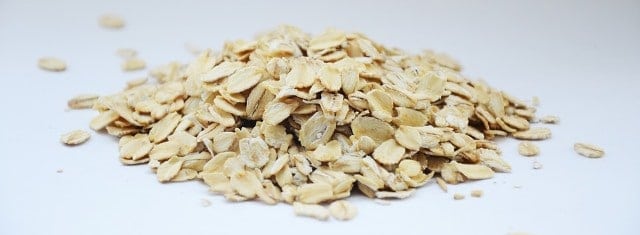
- Oatmeal has an anti-inflammatory effect on the skin. It helps in reducing irritation and itchiness and promotes skin healing.
- Oatmeal can be added to a bathtub filled with warm water along with baking soda (two cups and one cup respectively). This soothing bath can be taken twice a day.
- Oatmeal can be applied to the skin by making a paste with a bit of cornstarch and sufficient water. Let the paste act on the skin for fifteen to twenty minutes per day and wash it with warm water.
6. Apple Cider Vinegar
- This has antihistamine properties. It will reduce the inflammation in a short time and benefit your skin overall.
- Apple cider vinegar can be added to the bathtub filled with warm water or used diluted with water to wash the affected area on the skin twice a day.
- It can be used as a drink to boost the immune system also. Add two teaspoons of apple cider vinegar and a spoonful of honey into a glass of water.
7. Aloe Vera
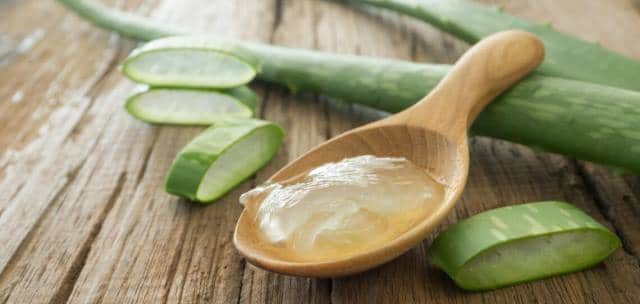
- Aloe Vera is a plant that is extremely beneficial for the skin. Its antimicrobial and anti-inflammatory properties help in reducing inflammation, irritation, redness, and swelling. It also boosts immunity when taken orally.
- The gel from Aloe Vera can be applied to the affected skin directly. It can be rinsed after 15 minutes with water. This process can be repeated several times per day.
- Aloe Vera can be taken in the form of juice to boost the immune system. However, this should be avoided by pregnant women and small children.
8. Basil
- Basil leaves can be dried and crushed before applying them to the affected skin directly or with the help of water.
- Allow the mixture to dry and rinse with lukewarm water. This remedy has antihistamine properties and helps in decreasing inflammation and itching.
9. Mint Leaves
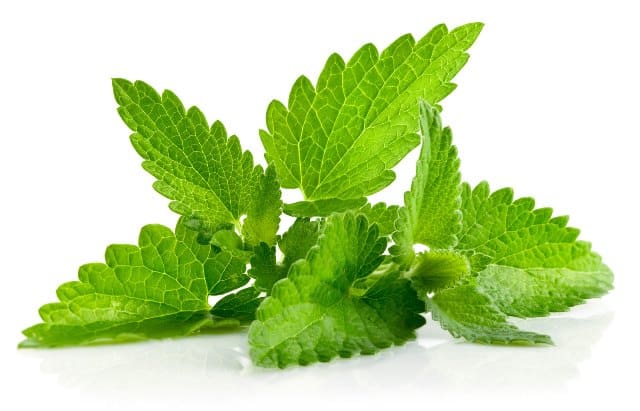
- This plant has a well-known cooling effect. Along with its antioxidant and anti-inflammatory properties, it speeds up the recovery by a decrease in the itchiness and burning.
- To wash the affected area, use crushed mint leaves and boiling water. Put the mixture in the fridge and allow it to cool before applying it to the skin.
- Mint can also be ingested as mint-tea. Boil one teaspoon of dry or crushed mint leaves in a cup of water. Add sugar if required and drink it after straining it.
10. Witch Hazel
This plant extract has a shrinking effect on the blood vessels. This inhibits the release of histamine that can trigger the hives, and thus, reduce and cure them. Witch hazel can be applied to the skin and left for a few minutes before washing it off.
11. Tea
Drinking tea made from the extracts of licorice root can reduce the inflammation caused by hives. The Licorice root tea should be brewed for fifteen minutes. Honey can be added to enhance the taste.
Another effective tea for the treatment of hives is green tea.
12.Stinging Nettle

Its amazing that same plant which causes hives can actually cure it.Stinging Nettle root tea has substances which can cure the chronic hives.You can buy stinging nettle tea from Amazon and try this remedy.
13.Vitamin C
Vitamin C and Zinc tablets can be mixed and applied to the skin. This mixture will reduce the effects of histamine and decrease the discomfort caused by hives.
14.Fish Oil
Capsules made from fish oil have fatty acids that help to mitigate the skin inflammation. Fish oil can be taken in the form of capsules or as food.
15.Carrom Seeds & Jaggery
Consume the mixture of 1 gram of carom seeds with 3 grams of jaggery. This is a beneficial remedy to cure urticaria.
Hives are not a harmful condition in most of the cases. It usually heals on its own within a few days. Self-care and management of hives at home, with the help of natural remedies, can cure hives completely. However, urgent medical treatment is necessary when hives cause the development of swelling in the air passages and restrict breathing.
Hives On Face & How To Get Rid Of
Hives on a face are termed as facial hives. They appear as soft bumps that are red. They can occur in the eyes, lips, and ears and spread to the neck and upper arms.
These also produce an extreme itchiness and burning sensation, especially when touched. The condition resembles a sunburn.
Facial hives can be associated with angioedema, and they are prone to keep reoccurring in the absence of appropriate treatment.
The common causes are allergies, sun exposure, cosmetics, drugs, excessive cold, insect stings, pollen, diseases like Lupus or Leukemia.
They can be temporarily relieved by splashing cold water on the face few times per day, but their permanent treatment requires medical assistance.
Are Hives Contagious?
Hives are not a contagious condition in itself. However, when they are triggered by agents like viruses, bacteria or parasites, they may still contain them.
In this case, hives can be transferred between people. Hives can occur within 24 to 48 hours of coming in contact with the infectious agent. Children and pregnant women are at a higher risk of developing hives.
Symptoms Of Hives
Hives resemble bug bites. The symptoms they cause can last different periods of time in different people, from minutes to months. Typically, they disappear within a day, but they can reappear again, and continue for a few weeks.
The most characteristic symptoms of hives are:
a. Red, pink, or skin-colored swollen bumps with clear edges. They appear suddenly and may disappear within a day but reappear in another zone.
b. The welts can be present alone or connect with each other to expand the affected area, surrounded by a red-colored flare. They may have a changing shape. Their size varies from millimeters do decimeters. They commonly appear on the face and limbs.
c. Itching, hurting, burning, or stinging sensation in the hives.
d. Blanching (the whitening of a red hive on pressure)
e. In the case of chronic urticaria, internal organs like the lungs, muscles, or the intestine can be affected and give rise to breath-shortness, vomiting, diarrhea, or muscle soreness.
What Are The Causes Of Hives?
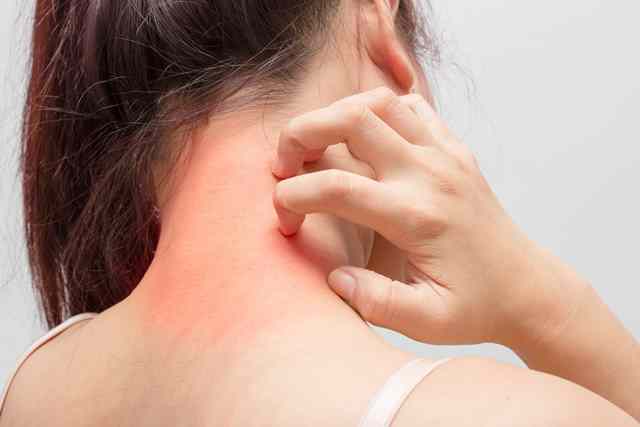
Hives can appear on any skin, at any age, and in any gender. Anyone can get them. The cause of hives is often an allergic reaction, but it is not the only one.
When hives are caused due to allergies blood plasma leaks out of a small blood vessel in response to histamine.
The factors that trigger hives include:
i. Allergic Reactions
Certain agents trigger the release of histamine from specialized cells that are found in the blood vessels of the skin. The reaction makes blood plasma leak from these vessels, and it results in the abnormal appearance of the skin, or hives.
These agents are known as allergens, and they include:
- Pollen
- Animals
- Materials such as latex
- Medicines or drugs like aspirin, ibuprofen, painkillers, etc.
- Food items: fruits, milk, eggs, dry fruits, etc.
- Food additives and preservatives
- Insect stings or bites
ii. Other factors that can trigger the onset of hives are:
iii. Physical factors like excessive exposure to heat, cold, water, or sun (solar urticaria), excessive scratching and extreme pressure on the skin. These factors cause a condition known as physical urticaria.
iv. Physical and mental stress can also trigger the onset of hives by the alteration in the immune system due to these sensations.
v. Infections caused by bacteria or fungi can manifest their presence on the skin and cause red, swollen bumps accompanied by itchiness and discomfort.
vi. Diseases like lupus, thyroid disorders, and vasculitis give a warning of their presence through abnormalities in the normal pigmentation of the skin.
vii. Chemical substances can affect the skin and alter its appearance.
Stress Hives
This condition is caused when hives develop on the skin due to chronic stress or tension. These emotions negatively influence the immune system and make it behave abnormally.
Stress hives manifest as the usual hives rashes, that is, red, swollen, raised bumps on the skin that may form larger belts and may itch severely.
It can appear on the face, neck, chest, and other body parts. The treatment of stress hives requires the removal of the stress factor in the life of the patient or the source that causes such stress.
What Are Different Types Of Hives?
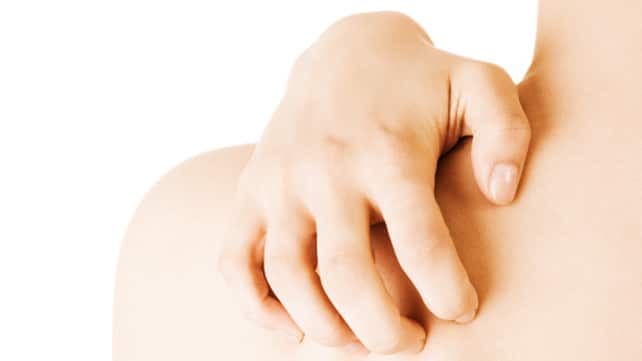
What Are Different Types Of Hives
Hives can be of two types: acute and chronic. Both of the types are normally harmless unless the swelling occurs in the throat or the air passages and restricts breathing. When this happens, medical assistance is urgently required.
- Acute urticaria: The hives are short-lived, and they tend to disappear completely within six weeks. They are caused by food, medicines, diseases, infections, or insect bites.
- Chronic urticaria: The hives are long-lived. They can continue to appear and disappear for more than six weeks, and they cause several itching. They can be caused due to thyroid disorders, cancer, or hepatitis.
- Fixed Hives: They are also known as physical urticaria. These are hives that do not present any movement. They take place in response to certain medicines (drug eruption) or excessive exposure to sunlight (solar urticaria), cold, heat, vibration, sweating, pressure, and exercise.
Treatment Of Hives
Hives not only produce marks on the skin but also cause a very uncomfortable sensation of itching and burning. To relieve these symptoms, the doctor may prescribe and recommend the following:
- Drugs like antihistamines, corticosteroids, omalizumab.
- Anti-inflammatory medications to calm down the reactions of the immune system.
- Antibiotics like dapsone in case the urticaria was caused due to a microorganism like fungi or bacteria.
It should be considered that some of the medicines might have side effects like drowsiness on the body.
Management Of Hives
Apart from the medicines prescribed by the doctor, there are a series of methods to help in soothing the symptoms of hives at home. These imply taking care of aspects like:
- Food: Avoid the food items that may result to be an allergen.
- Skincare: Do not rub, scratch, or use harsh substances on the skin (like strong soaps). On the other hand, bathing with luke-warm or cool water can make the skin feel better. Applying wet clothes or cool compresses on the affected skin also helps.
- Clothing: Do not wear tight-fitting clothes that may impose pressure on the skin.
- Ambient temperature: Avoid exposure to cold weather by using warm clothing and covering the neck, nose, and mouth. Excessive heat is not beneficial either; try to remain at a comfortable temperature.
- Sunlight exposure: Do not expose your skin directly to the solar rays. Wear clothes and sunscreen to protect it.
- Medications: Consult your doctor in case you suspect a certain medication is causing hives on your skin.
Diagnosis Of Hives
Urticaria is diagnosed by a dermatologist. Its distinctive appearance helps in its identification, but determining the cause can be more difficult.
The triggering factor of hives can be found out by considering:
- The health history of the patient.
- Questions about the symptoms, their intensity, and duration.
- Physical exam and skin tests in an attempt to determine the cause. These tests include:
- Allergy tests of the skin or blood.
- A skin biopsy. This will be done by removing a small portion of the affected skin and examining it under the microscope.
- Blood tests to determine whether the cause is an infection.
Also, Read
Urticaria Pigmentosa : Causes,Symptoms & Home Remedies

